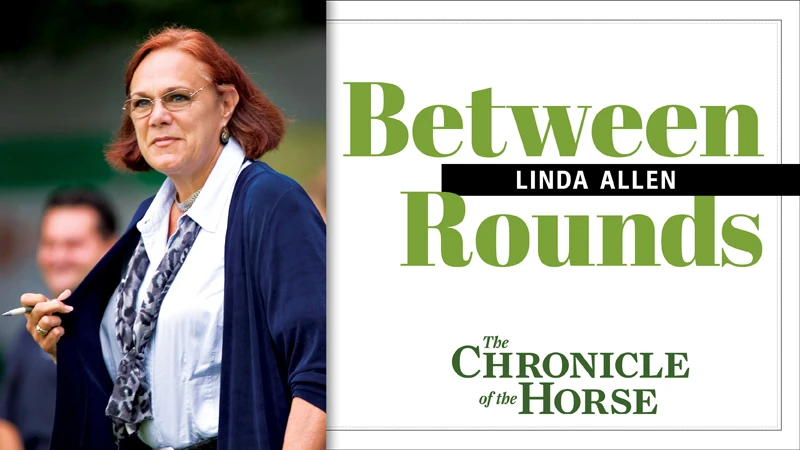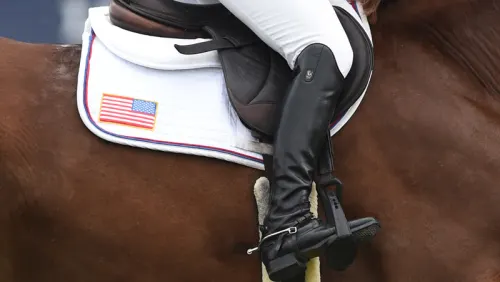On the international front, 2009 was the “off year” of the quadrennial for senior championships and games. We will complete this quad with the Alltech FEI World Equestrian Games (here in Kentucky) later this year, the Pan American Games (in Guadalajara, Mexico) in 2011 and the Olympic Games (in London) in 2012.
Early in the year the show jumping world once again traveled to Las Vegas, Nev., to contest the Rolex FEI World Cup Final. Produced to its customary high standard, spectators watched some of the world’s best jump very big and difficult courses in the most confined of spaces.
The jumping was spectacular over Anthony D’Ambrosio’s excellent courses, with a result that was exciting down to the final fence jumped. Meredith Michaels-Beerbaum has ridden for Germany for some years now, but many in the audience still remember her as a California native, so she had a big cheering section.
Together with her venerable partner Shutterfly, she managed to hold off our own McLain Ward on his superstar mare Sapphire, the Chronicle’s 2009 Show Jumping Horse of the Year (p. 78). With this win, Meredith accomplished two feats in one: winning her third World Cup title and doing it by leading wire-to-wire with wins in all three legs.
Only a handful of other riders have accomplished one of these feats, and to do both in one spectacular demonstration of riding, jumping and sheer calculating nerve was most impressive to watch. It is a big loss for American fans that this event isn’t scheduled to return to Las Vegas, at least in the immediate future. For those who traveled to Las Vegas in 2009 it was certainly worth the effort.
The international scene certainly doesn’t go dark around the world on the years without a WEG or Olympic Games. In Europe, the former Samsung Super League morphed this past year into the Meydan FEI Nations Cup Series.
Our senior athletes, led by Chefs d’Equipe George Morris and Melanie Smith Taylor, had success throughout these most prestigious summer events, while also utilizing the year to strengthen the experience of some new combinations.
Our finish at the end of the series was a very respectable second place behind France. There was a bit of drama at the end when it became unclear which teams were to be relegated out of the elite group of nations eligible to participate in 2010. Rules hadn’t taken into account the possibility of ties!
On Jan. 22, the FEI Tribunal members decided not to intervene on the decision, so Great Britain, Belgium and Italy will not be participating this year. It goes to show that even the most experienced rule makers can sometimes forget something important!
Young Riders Challenges
ADVERTISEMENT
The only other international show jumping championship held on our own shores was the Adequan FEI North American Junior and Young Rider Championships. Moved to the Kentucky Horse Park for the first time, riders 21 and under from a variety of different disciplines had the opportunity to test much of the expanded venue being prepared for the WEG.
This competition is always an important opportunity for upcoming international riders from various zones of the United States, Eastern and Western Canada, and Northern and Southern Mexico.
Unfortunately, there remains a great deal of discrepancy in the degree of preparation of the riders as well as the level of experience of their mounts. This situation leads to a wide range of scores. Winning this event means a lot, especially since from all accounts the course difficulty for the team events was fully to the high standard set at the European events.
Not every young rider has the opportunity to be mounted on experienced grand prix horses in order to come into this competition with extensive experience competing at a strong 1.50m level. More than a few participants have expressed serious doubts about committing to the travel involved for future events.
What disturbs them the most is that for a couple of years now the least experienced team members have had to face challenges in the team event exceeding those put to the select group of riders who go on to qualify for the individual final.
Much as we would like to be equal to Europe—where the European Young Riders Championship has been the final proving ground for those about to go on to senior teams—it remains the case on our side of the “pond” that most of the competitors are still a ways away from this elite level. Most of their preparations come from the junior and amateur-owner classes at our horse shows.
I believe it’s possible to make this a true championship without over facing riders and horses in the first two days of the event. This event should be a welcome challenge that attracts every serious rider, one that best promotes the sport in America, not one that proves to be a demoralizing experience that discourages future participation.
Emerging Athletes
On the national front, the economy didn’t appear to have a dramatic effect on the roster of FEI-sanctioned events or the participants in them.
National grand prix events seemed affected in some areas more than others. Events such as the USEF Prix de States Junior Jumper Championships (won by Zone 10 for the team, and Reed Kessler on Ice D’Ancoeur claiming the individual) and the USEF National Pony Jumper Championship (Zone 8 winners of the team, and Sydney Shulman on Set Sail taking the individual, with Carly Attanasio representing the U.S. Pony Clubs team in silver) were strongly contested.
ADVERTISEMENT
The Young Jumper Championships remained strong as well with the finals in all three locations drawing full complements of top contenders.
While the prestige and financial reward that comes with winning an age group at a regional final is important, the YJC leaders consider the most important aspect of the program the success of YJC graduates as they go on to compete in open competition. Competing young horses should be a means to an end rather than the end itself.
One individual followed up wins as a 5- and 6-year-old, and a reserve at 7, with continuing success: Apache (by Mescalero out of a Thoroughbred mare).
Doug White purchased the typey gelding as a young horse and saw to his early years of proper training. Grand prix rider Richard Spooner spotted him as a 5-year-old and took him the rest of the way, winning the $50,000 Los Angeles National Grand Prix CSI-W in fine style at the Los Angeles National Horse Show last November. With some more emphasis on recognizing and developing this type of horse we could hope to have more American-bred horses representing us at the highest levels of the sport.
In the same vein of recognizing talent for the future, a new program was undertaken in 2009 by the U.S. Hunter Jumper Association together with Melanie Smith Taylor: the Emerging Athletes Program.
With clinics offered in various parts of the country, selected young athletes were offered learning opportunities at three different levels. The final tier comprised 12 riders who were selected from all of the participants nationwide for their natural riding talent, interest in all aspects of horsemanship and their work ethic.
This final event placed each of the riders on strange horses provided by Maplewood Stables in Reno, Nev. Julie Winkel, Maplewood Stables’ owner and clinician for many of the Level 2 clinics, was impressed with the caliber of the riders who participated throughout the country. She said that it was a valuable program going forward to offer younger riders the opportunity to show their potential and learn in a conducive environment. It boistered their beliefs that becoming a more complete horseman will have on their future in the industry and the sport.
The two riders receiving the highest recognition at the end of this inaugural year of the program were Carly Anthony from Washington and Ricky Neal from California.
Noted international course designer Linda Allen created the show jumping courses for the 1996 Atlanta Olympics and the 1992 FEI World Cup Finals. She’s a licensed judge, technical delegate and a former international show jumper. She lives in Fillmore, Calif., and San Juan Cosalá, Jalisco, Mexico, and founded the International Jumper Futurity and the Young Jumper Championships. Allen began writing Between Rounds columns in 2001.
If you enjoyed this article and would like to read more like it, consider subscribing. “This “Off Year” Focused On The Young” ran in the February 5, 2010 issue. Check out the table of contents to see what great stories are in the magazine this week.















